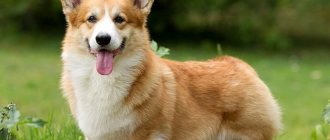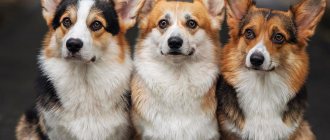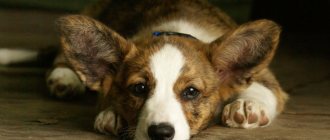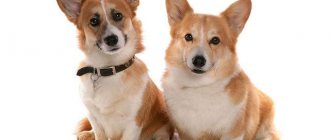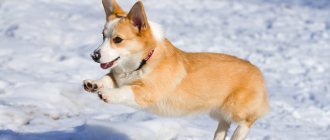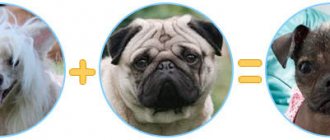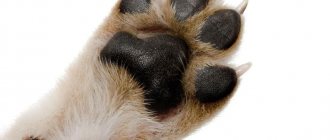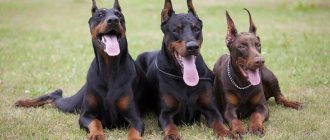The Welsh Corgi is a very ancient Old English breed of dog.
It is not known for certain when the breed originated, but it became widespread in the 10th century! The word “corgi” itself is also unclear where it came from: some researchers say that the source was the Welsh cor gi (cor - “dwarf” and ci - “dog”). Others believe that “legs grow” from the modified cur (“watch, guard”) and ci (“dog”).
According to one legend, elves gave Welsh Corgi puppies to people, for whom corgis were something like horses. Since then, some corgis have had a saddle-shaped mark on their backs. Indeed, this pattern is still found today among Pembrokes, especially the tricolor ones.
According to another Welsh legend, two corgi puppies were found in the forest by peasant children and brought home. Since then, Welsh Corgis have become faithful companions and helpers of the common people.
on the left is a Pembroke Welsh Corgi. On the right is a Welsh Corgi Cardigan
External difference
At first glance, both Welsh Corgis are similar. But, if you look closely, there are significant differences in the exterior of Pembroke and Cardigan.
Tail
The main difference between corgis is their tails. In 1934, when the breeds were officially separated, the Pembrokes decided to dock them to emphasize the difference.
And cardies always wore long, bushy ponytails.
Many Pembrokes are born bobtailed. If not, the tail is shortened.
However, in 2012 the situation changed. Dog training organizations in Europe have recognized docking as a cruel and unnecessary procedure. That's why most Pembrokeshires now sport long tails.
In Russia they prefer to shorten their tails. Therefore, residents of the CIS countries are guided by this difference.
Dimensions
The second thing that distinguishes a cardigan from a Pembroke is weight and physique. With the same height at the withers (30 cm, deviations of a couple of centimeters are allowed), the sizes of the two Welsh Corgi breeds are different.
Cardigans weigh from 13.6 kg to 17.3 kg, and Pembrokes - 10-11 kg. The first ones are heavy and massive. The difference between the latter is in the proportional body and light constitution.
The Pembroke also differs from the cardigan in its skeleton. The former have bones with sharp angles, while the latter have rounded bones with many curved lines.
Uncontrolled breeding of Welsh Corgis has changed the breed's characteristics. Pembrokes weighing 15-16 kg, and chiseled cardies with sharp bone angles are increasingly appearing.
Paws
In Pembrokes, oval pads and cat-like paws or markings are considered disqualifying faults. For cardigans, they are rounded, gathered into a ball, the front legs may be splayed. This difference is noticeable when viewed from the front.
Ears
Both breeds have long, fox-like ears. However, cardigans are larger with more rounded ends.
Eyes
In Pembrokes, only brown shades of the iris are allowed; in Cardigans with blue merle color, blue or its inclusions are possible.
Wool
Both dogs have coats of medium length, thick, with dense undercoat. But cardigans have tougher guard hairs.
Suit
The main external differences between the Pembroke and Cardigan Welsh Corgis are colors. The first dogs are allowed red, sable, tricolor. In addition to the indicated colors, the latter have blue merle and brindle.
Both pets are allowed white markings on the body, paws and head.
Although the dogs are similar in color, the Cardigan's white spots are distributed so that on the back they form a pattern similar to a saddle or vest. Presumably, the peculiarity is reflected in the name: the word “cardigan” is translated from English as vest.
The external differences between the two Welsh Corgis are visible in the photo. Cardigans have a muzzle similar to German Shepherds, their expression is calm and reasonable. And the natives of Pembrokeshire are typical foxes with a mischievous, cunning face.
Welsh Corgi is the favorite dog of Queen Elizabeth of England
Despite their antiquity, these dogs were not popular for a long time. They did not participate in exhibitions and were not fashionable. Everything changed when, in 1933, her father gave his daughters Elizabeth and Margaret two Pembroke Welsh Corgi puppies. The girls (one of whom is the current Queen of Great Britain) were crazy about these dogs and loved this breed so much that now 17 Pembroke Welsh Corgis live in the Queen’s house.
welsh corgi pembroke puppies
Of course, a dog breed so popular with the royal family could no longer remain in the shadows. Now there are many more owners of Welsh Corgis, and among them there are many stars: Stephen King, Ava Gardner, Gary Cooper, Liza Minnelli, Stephen Fry, Gregory Peck, Mickey Rooney, Kiefer Sutherland, Fyodor Bondarchuk, Sergei Belogolovtsev, Alexey Vorobyov. The list goes on.
Reasonableness versus frivolity
Both Welsh Corgi dogs are friendly, non-vicious, sociable and loving pets. They love walks and are ready to run around the park and forest for hours.
But the Cardigan and Pembroke Welsh Corgis differ in temperament. Shepherds from Cardiganshire are quiet at home, unobtrusive. They love family, but do not follow their owner's trail. And the first thing they will do after a walk is fall asleep.
Unlike the cardigan, Pembrokes are eternal energizers. Dogs stick their curious noses into everything, demand attention, and beg to play with them.
Welsh Corgis are wary of strangers. But natives of Pembrokeshire quickly get used to strangers and are open to communication. In contrast, cardies take a long time to look at strangers.
Pembrokes are characterized by foolishness and frivolity. They act first and think later. Cardigans always weigh the pros and cons.
On opposite sides of the mountains: the origins of both corgi babies
The Pembroke Welsh Corgi and the Cardigan have the same homeland - the county of Wales.
But the breeds practically did not interbreed. This is explained by the fact that the dogs were selected in different counties, separated by a difficult mountain range. Pembrocks were bred in Pembrokeshire, and Cardigans in Cardiganshire (now Ceredigion).
The differences between the dogs can be easily seen in the name. "Welsh" means Welsh, "corgi" is Welsh for "dwarf dog".
The word “pembroke” is derived from the area where the animals were bred, and “cardigan” not only speaks of the small homeland of the dogs, but also means a vest.
These breeds are the only small-sized herding dogs. They were deliberately “reduced” so that the dogs could dodge hooves and horns.
The ancestors of the corgi appeared in Wales at different times. Cardigans are an older breed. It is believed that they were brought to the lands of Great Britain by the Celts even BC, at the end of the Bronze Age. Written sources that talk about pets date back to the 10th century.
The first mentions of the Pembrokes date back to the 13th century. Presumably, the ancestors of the dogs were brought with them by Flemish artisans.
Despite their similar appearance, Pembrokes and Cardigans have different ancestors. The ancestors of the first were Spitz-type dogs, the second - dachshund dogs.
Also, Pembrokes have the blood of aboriginal dogs, and Cardigans have the blood of heeler herding dogs. The animals received this name from the manner of herding work: when guiding cows and sheep, they bite their paws.
We recommend reading: The best dogs for an apartment: a review of 10 breeds.
Difference in upbringing
Comparing dogs during training reveals another difference. Although both breeds are easy to raise, the Pembroke will fray the nerves of owners. They are smart, but sometimes capricious, distracted by strangers, animals, sounds and smells.
The cardigan is focused on the wearer. For him, on the training ground there is only him and his person. The dogs seem somewhat inhibited. But pets are not stupid - they need time to comprehend the command, think about how best to do it and why the order is needed.
What are the similarities and photos of what they look like
Both breeds were bred on the lands of Wales to help shepherds, but if the Pembroke appeared in Pembrokeshire, then the Cardigan - in Cardiganshire.
The regions were separated by a mountain range, and therefore could not have common descendants. However, the dogs are already similar to each other. Be it the shape of the head or ears.
The similarity in proportions is expressed in the ratio of head and body as 1/5 to three . Both breeds have a stocky build and give the appearance of a working dog. But this is not surprising if the animals share the same past.
Difference in work
The main point for farmers in which Welsh Corgis differ is their manner of work. The breeds are natural shepherds. But they graze livestock differently.
In the field, cardigans will first reach the edge of the territory, then walk around its perimeter, and only then return to the owner. In contrast, Pembrokes will run to the middle of the “possession”, from where they will watch the cattle and the owner. When herding a herd, the first dogs move in zigzags, the second dogs move in a straight line.
Dogs also differ in endurance. Cardies cover huge distances with a pulling step, Pembrokes move quickly, but quickly run out of steam.
Differences are also noticeable in gait. Cardies run jerkily and heavily, while Pembrokeshires run at a smooth trot.
Pembrokes and Cardigans are the smallest shepherds in the world
Welsh Corgis belong to the shepherd family of herding dogs. Contrary to misconceptions, their miniature stature not only did not interfere, but also helped the Welsh Corgi to properly cope with the duties of a shepherd: they quickly dodge the hooves of animals when grazing, and if the animal tried to kick the dog, the corgi’s hooves whistled over the corgi’s head.
Even today, Welsh Corgis have not lost their instinct to protect and “bring together” everyone (from ducks and rams to family members). This manifests itself in different representatives of this breed in different ways: from delicate squeaking and whining if the family has scattered in all directions, to energetic, but not strong, biting of the heels (this is what these dogs do with sheep). However, many corgis wean themselves from the habit of “herding the herd” by biting their legs very quickly - it’s enough to express your displeasure a couple of times. Corgis are very intelligent and delicate dogs. They have good ingenuity, wit and resourcefulness.
Corgis have a menacing and deep voice for their small stature. More than once, corgi owners have noted that strangers do not risk entering an apartment with a corgi until they see it. Welsh Corgis are alert, but not loud. They will not make a fuss and fuss over a trifle.
Health
When thinking about who is better, the Cardigan or the Pembroke, one should not overlook the diseases characteristic of the breeds. The dogs are strong, hardy, and live up to 13-15 years. But both have problems with the spine, joints, and eyes. Also, due to the long body, all Welsh Corgis give birth on their own only in 20% of cases - in other cases they have a cesarean section.
Pembrokes are more likely to suffer from eye pathologies - 25% versus 6% for Cardies.
Differences between breeds are manifested in characteristic diseases. So, Pembrokes are susceptible to:
- epilepsy;
- wet eczema;
- narcolepsy;
- defects of the cervical vertebrae;
- thyroid hormone deficiency;
- poor blood clotting.
Cardigans have:
- glaucoma;
- insufficient production of immunoglobulin;
- entropion of the eyelids;
- intervertebral hernias.
This doesn't mean Cardi won't get eczema or epilepsy. It’s just that some pathologies are more common in the breed, while others are less common.
Who is more picky about feeding?
Corgis have no special dietary preferences; on the contrary, dogs have a large appetite . Therefore, the owner needs to be able to refuse the pet if it asks for more over and over again.
For both the Cardigan and the Pembroke, food is divided into natural and dry food. And the basis of the diet is protein. Along with carbohydrates.
Cookies are active pets, and therefore nutrition should keep pace with the load . An increase in one provokes a need for an increase in the other.
CAREFULLY!
The breed is prone to obesity.
Self-discipline regarding food is difficult for Welsh Corgis; moreover, dogs have a poorly developed sense of satiety.
Cost difference
The prices of both varieties of Corgi are high. This is explained by the difficulty in breeding - the long body complicates mating and childbirth.
The difference in cost is small. But cardies are sold a little cheaper. Average prices in rubles are given below.
| Puppy class | Cardigans | Pembrokes |
| Pat | 30 000-35 000 | 40 000-50 000 |
| Breed | 50 000 | 70 000 |
| Show | 70 000-80 000 | 100,000 and above |
Training
- In terms of temperament, since childhood, Pembroke Welsh Corgis differ from Cardigans . The first ones will strongly show their curiosity, so it is better to immediately hide everything that the baby can chew. But cardigans are calmer; they will seek your affection and respond to every comment.
- From a young age, prohibit children from everything that is prohibited for a large dog, and you should never allow prohibited things. Dog handlers recommend accustoming your Pembroke puppy to a crate that he will consider his home. Inside, equip it with all the necessary amenities, a booth, and toys. This is necessary to prevent your dog from causing chaos at home while you are away. But a cardigan, with proper upbringing, will be able to maintain order at home; he does not need a cage.
- Pembroke will be persistent during training; you will have to be patient to gain leadership and teach your pet the necessary commands. And the cardigan reacts more attentively to training, fulfills any requirements with pleasure, loves praise and encouragement.
Care and maintenance
Cardigan and Pembroke get along in apartments and private houses. At the same time, in any room the pet needs its own space in the form of a bed and toys. Corgi care includes timely vaccination, treatment for fleas, helminths, and ticks. It is also important to maintain the dog’s hygiene, regular examination of the eyes, teeth, and ears.
Hygiene
Expert opinion
Anna Abramenko
An avid dog lover. Experience in veterinary medicine since 2009.
Ask a Question
Pembroke and cardigan require constant maintenance of cleanliness. These processes are the same for the two breeds. During the shedding period, the corgi's coat is combed every day using special brushes. The rest of the time, this procedure is carried out several times a week.
Welsh Corgis need to be washed using special shampoos, preferably 2–4 times a year, so as not to destroy the protective layer on the pet’s skin and coat. Special attention must be paid to the hygiene of the eyes and ears: cleanse once a week, while ensuring that no inflammation, discharge or pus appears. To prevent problems with your teeth, you should brush them with a special paste that prevents plaque.
Note! If the corgi does not move much on the asphalt surface, which helps wear down the claws, it is necessary to trim them as they grow back.
Nutrition
Both breeds are not picky when it comes to food; one might say, they are omnivores. But owners need to monitor their diet and make sure that they do not overeat, since Corgis are prone to excess weight.
Expert opinion
Anna Abramenko
An avid dog lover. Experience in veterinary medicine since 2009.
Ask a Question
For a Cardigan or Pembroke, you should initially choose the type of food: ready-made dry food or natural. If you choose a natural diet, it should be based on protein foods with vegetables, offal and milk. Supplement your pet's diet with vitamins and microelements.
Attention! Since corgis are active dogs, it must be remembered that as physical activity increases, the portion of food should be proportionally increased.
There are foods that are prohibited for both types of corgi breeds:
- smoked, fatty, salty, fried foods;
- raisins, any confectionery sweets, chocolate;
- spicy dishes, chicken bones, sausage.
Possible diseases
Corgis have good health, so they rarely suffer from any diseases. However, due to heredity, they may develop some ailments.
Pembroke diseases:
- Eye cataract.
- Problems with the cornea.
- Skin diseases.
- Epilepsy.
- Blood clotting disorder.
- Narcolepsy.
Cardigan diseases:
- Turn of the century.
- Glaucoma.
- Intervertebral disc diseases.
- Immune deficiency.
Size and weight
icon-angle-double-right
Size is a fairly clear difference between one type and another. Cardigan is larger than Pembroke.
- icon-angle-double-right
Both breeds look quite strong and stocky at first glance. However, their parameters indicate some differences. - icon-angle-double-right
The length of the cardigan is several times greater than its height. Varies from 26 to 32 cm. The standard weight for males is from 13 to 17 kg, for females it is 11-15 kg.
icon-angle-double-right
Pembroke is smaller in size. On average, its height is from 25 to 30 cm. Moreover, a Pembroke should not be heavier than 13 kg if it is a male and 12 kg if it is a female.
